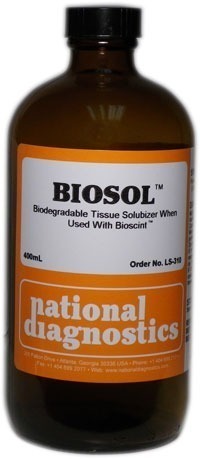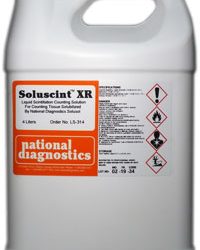Liquid Scintillation
Biosol
$212.00
Catalog Number: LS-310
Size: 400 ml
- Biodegradable Tissue Solubilizer for use with Bioscint
- Nonhazardous Waste when combined with Bioscint
- Clear Emulsions for Excellent Counting
Description
Catalog Number: LS-310
Size: 400 ml
- Biodegradable Tissue Solubilizer for use with Bioscint
- Nonhazardous Waste when combined with Bioscint
- Clear Emulsions for Excellent Counting
When used together, Biosol and Bioscint form a non-hazardous, biodegradable tissue solubilizer and scintillation solution. The solubilizer, Biosol, is designed to be used with a variety of samples, including tissue, filters, and polyacrylamide gels (for best results, these samples should be finely divided prior to digestion, to present the largest surface area to the solubilizer). Bioscint is our neutralizing scintillation solution. Used in combination with Biosol, Bioscint eliminates chemiluminescence and renders the solubilizer nonhazardous.
One (1) part Biosol must be mixed with ten (10) parts Bioscint to be disposed of as non-hazardous waste under EPA 40 CFR Subpart C. Neither Biosol nor Bioscint can be disposed of separately as nonhazardous waste. Biosol is compatible with all aqueous scintillation solutions. However, only Bioscint will render the solution nonhazardous for disposal.
Storage: Biosol is corrosive, and is best stored tightly capped in a cool dry area.
Additional information
| Weight | 3 lbs |
|---|---|
| Dimensions | 7 × 7 × 11 in |
MSDS Safety Overview
Safety Summary (see SDS for complete information before using product):
EMERGENCY OVERVIEW – IMMEDIATE HAZARD
DANGER! CORROSIVE. CAUSES SEVERE BURNS TO SKIN, EYES, RESPIRATORY TRACT, AND GASTROINTESTINAL TRACT. MATERIAL IS EXTREMELY DESTRUCTIVE TO ALL BODY TISSUES. MAY BE FATAL IF SWALLOWED. HARMFUL IF INHALED. (The health effects of exposure to diluted forms of this chemical are not well documented. They are expected to be less severe than those for concentrated forms which are referenced in the descriptions below.)
- Waste Disposal Issues in Scintillation Counting
- The Complete Scintillation Cocktail
- Radioactive Emissions and the Use of Isotopes in Research
- Preparing Tissue Samples for Scintillation Counting
- Preparing Samples in PAGE Gels for LSC
- Mechanism of Liquid Scintillation Counting
- Measurement of Radiation and Isotope Quantitation
- Liquid Scintillation Signal Interpretation
- Liquid Scintillation and Radiation Safety
- HPLC Flow Counting
- Counting Samples on Cellulose-Ester Filters
- Counting Samples from TLC Plates by LSC
- Counting Efficiency and Quenching
- Counting Carbon Dioxide by LSC
- Chemiluminescence and Static Electricity
- Assaying Discrete Samples by Liquid Scintillation Counting



